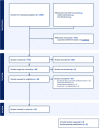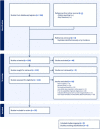This is a preprint.
Systematic Review of Treatment of Beta-Cell Monogenic Diabetes
- PMID: 37214872
- PMCID: PMC10197799
- DOI: 10.1101/2023.05.12.23289807
Systematic Review of Treatment of Beta-Cell Monogenic Diabetes
Update in
-
Precision treatment of beta-cell monogenic diabetes: a systematic review.Commun Med (Lond). 2024 Jul 18;4(1):145. doi: 10.1038/s43856-024-00556-1. Commun Med (Lond). 2024. PMID: 39025920 Free PMC article.
Abstract
Background: Beta-cell monogenic forms of diabetes are the area of diabetes care with the strongest support for precision medicine. We reviewed treatment of hyperglycemia in GCK-related hyperglycemia, HNF1A-HNF4A- and HNF1B-diabetes, Mitochondrial diabetes (MD) due to m.3243A>G variant, 6q24-transient neonatal diabetes (TND) and SLC19A2-diabetes.
Methods: Systematic reviews with data from PubMed, MEDLINE and Embase were performed for the different subtypes. Individual and group level data was extracted for glycemic outcomes in individuals with genetically confirmed monogenic diabetes.
Results: 147 studies met inclusion criteria with only six experimental studies and the rest being single case reports or cohort studies. Most studies had moderate or serious risk of bias.For GCK-related hyperglycemia, six studies (N=35) showed no deterioration in HbA1c on discontinuing glucose lowering therapy. A randomized trial (n=18 per group) showed that sulfonylureas (SU) were more effective in HNF1A-diabetes than in type 2 diabetes, and cohort and case studies supported SU effectiveness in lowering HbA1c. Two crossover trials (n=15 and n=16) suggested glinides and GLP-1 receptor agonists might be used in place of SU. Evidence for HNF4A-diabetes was limited. While some patients with HNF1B-diabetes (n=301) and MD (n=250) were treated with oral agents, most were on insulin. There was some support for the use of oral agents after relapse in 6q24-TND, and for thiamine improving glycemic control and reducing insulin requirement in SLC19A2-diabetes (less than half achieved insulin-independency).
Conclusion: There is limited evidence to guide the treatment in monogenic diabetes with most studies being non-randomized and small. The data supports: no treatment in GCK-related hyperglycemia; SU for HNF1A-diabetes. Further evidence is needed to examine the optimum treatment in monogenic subtypes.
Keywords: 6q24; GCK; Genetics; HNF1A; HNF1B; HNF4A; MODY; Mitochondrial diabetes; Monogenic Diabetes; Neonatal Diabetes; Precision Medicine; SLC19A2; Syndromic Diabetes; m.3243A>G.
Conflict of interest statement
Authors’ declaration of personal interests JK has received lecture fees from NovoNordisk, international conference costs covered by Medtronic, AstraZeneca and NovoNordisk; MP has been the scientific advisor for the AMGLIDIA (glibenclamide suspension) development; TV has served on scientific advisory panels, been part of speaker’s bureaus, and served as a consultant to, and/or received research support from Amgen, AstraZeneca, Boehringer Ingelheim, Eli Lilly, Gilead, GSK, Mundipharma, MSD/Merck, Novo Nordisk, Sanofi, and Sun Pharmaceuticals. RNN, KAP, JMEM, JS, JB, SAWG, ATH, TT report no conflicts of interest.
Figures
References
-
- Semple RK, Patel KA, Auh S, ADA/EASD PMDI, Brown RJ. Systematic review of genotype-stratified treatment for monogenic insulin resistance. medRxiv. 10.1101/2023.04.17.23288671 - DOI
-
- Riddle MC, Philipson LH, Rich SS, Carlsson A, Franks PW, Greeley SAW, Nolan JJ, Pearson ER, Zeitler PS, Hattersley AT. Monogenic Diabetes: From Genetic Insights to Population-Based Precision in Care. Reflections From a Diabetes Care Editors’ Expert Forum. Diabetes Care. 2020. Dec;43(12):3117–3128. doi: 10.2337/dci20-0065. - DOI - PMC - PubMed
-
- Chung WK, Erion K, Florez JC, Hattersley AT, Hivert MF, Lee CG, McCarthy MI, Nolan JJ, Norris JM, Pearson ER, Philipson L, McElvaine AT, Cefalu WT, Rich SS, Franks PW. Precision Medicine in Diabetes: A Consensus Report From the American Diabetes Association (ADA) and the European Association for the Study of Diabetes (EASD). Diabetes Care. 2020. Jul;43(7):1617–1635. doi: 10.2337/dci20-0022. - DOI - PMC - PubMed
-
- Greeley SAW, Polak M, Njølstad PR, Barbetti F, Williams R, Castano L, Raile K, Chi DV, Habeb A, Hattersley AT, Codner E. ISPAD Clinical Practice Consensus Guidelines 2022: The diagnosis and management of monogenic diabetes in children and adolescents. Pediatr Diabetes. 2022. Dec;23(8):1188–1211. doi: 10.1111/pedi.13426. - DOI - PMC - PubMed
Publication types
Grants and funding
LinkOut - more resources
Full Text Sources
Miscellaneous




